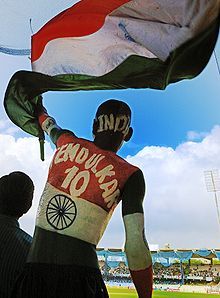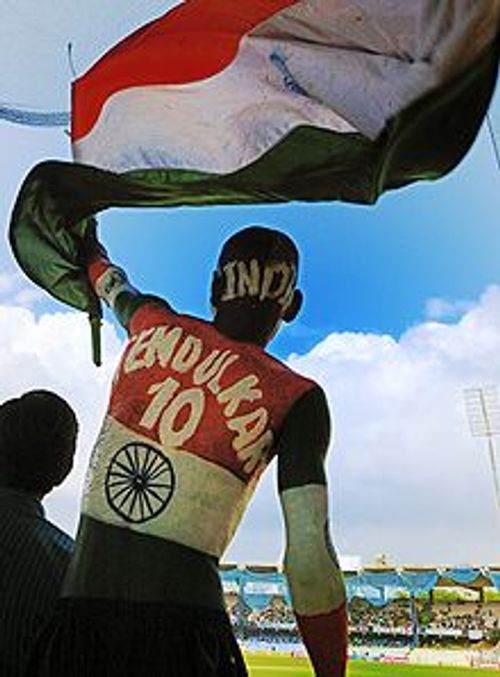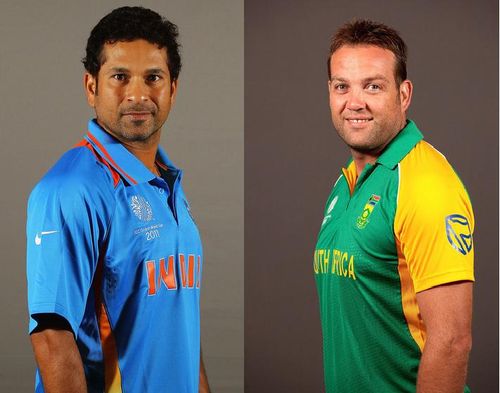
Is Sachin truly a cricketing God?

The God, the Lord, the Almighty or… Sachin Tendulkar? Living in Mumbai, I cannot be brave enough to speak my mind out on the streets. However, the pen is mightier than the bat. Or is that sword? I mean no offence. Sachin’s contribution to Indian cricket is insurmountable. Heaps of praises are nothing compared to the effort ‘the little master’ has put in over the last two decades. However, being called the “God” is neither just nor reasonable. In my quest to find my idol and ideal cricketing demi-God, I give you the following argument :
I will segregate the discussion into three portions to deliberate upon the three formats of the game.
Let us start with the ultimate test of skills – Test Matches.
Undisputedly, Tendulkar has the highest number of runs and centuries in test cricket. But, this comes with the highest number of innings and the longest career span too. It is thinkable that if many contemporary players had lasted this long, they might have trespassed the milestones set by Tendulkar easily. But all hope is not lost. Kallis is surely breathing down his neck and with Jayawardene and Sangakarra crossing 10,000 mark with age on their side, Tendulkar’s chances of lasting at the pole position look bleak. The other important milestones such as – best average, highest individual test score, centuries in 4th innings and scoring when it matters are still missing from Tendulkar’s CV. Yes, he has played some magnificent innings, but he is certainly not our crisis man.
If we contrast him with Mr. Dependable – Kallis, we can easily see that Kallis enjoys a better batting average (56.94) and a better innings/century ratio at 6.093 in comparison with 6.156 for Tendulkar. Slips are one of the most difficult positions to be on the field, for very little reaction time limit is granted to the fielder. Kallis, second only to Dravid, has held 187 catches in the few matches he has played. Sachin has taken 113 catches in Tests so far.
For me, God is omnipotent. Thus, God must possess certain bowling skills too. Kallis has taken 280 wickets at an average of 32.63 while Sachin has taken only 45 wickets at a bowling average equitable with his batting average at 54.46. Further, when India bats second, Tendulkar’s batting average drops to 43.97. Kallis, however, has his tail up and contributes towards building a lead over the first team’s total by contributing at an average of 55.85 runs per dismissal. In a Test match, chasing matters the most. Playing out dying pitches which spit, turn and bounce is a batsman’s nightmare. Kallis surpasses Tendulkar here too. Kallis scores at an average of 41.99 in 4th innings, while Sachin’s contribution lies at 37.85.
Statistics speak for themselves. Being surpassed and suppressed in the all three skills of the game, Tendulkar surely does not deserve to be the God of Test Cricket, at least.

Tendulkar holds identical records in ODIs too. He has the highest centuries, runs, matches and the longest career span in ODIs. But being an opener who has the entire 50 overs at his disposal, we can safely assume that he has the best chance of accumulating the maximum number of runs and having a commendable conversion rate. This is why the top run-getters in ODI cricket are the top order batsmen. Beating Tendulkar’s colossal mass of runs and centuries is an ask, but the likes of Kohli, Amla and Trott are surely marching towards the goal.
Comparing Tendulkar with Kallis, we find that Kallis enjoys a better batting average of 45.26 as compared to 44.83 for Sachin. Though the centuries scored by Tendulkar are unbeatable and the comparison will be a foolish one, a closely fought contest comes when we compare the half-centuries. Kallis will produce a half-century every 3.7 innings while Tendulkar will produce a half-century every 4.7 innings. However, Tendulkar leaves Kallis behind when we calculate the number of innings per all scores above 50 (3.07 v/s 3.14). Kallis is a better bowler claiming 270 wickets at an admirable average of 31.69. Tendulkar has 145 wickets at an average of 44.48, which includes two five wicket hauls at Kochi against Australia and Pakistan. Last but not least, Kallis clings on to 0.39 catches per match while Tendulkar holds an approximate 0.30 catches per match.
The left half of my brain refuses to accept Tendulkar as a better ODI player than Kallis. Surely, Kallis dominates the skill set in ODIs too.
The shortest format of the game – T20 – was born less than a decade ago. Yet, its popularity has sky-rocketed at an exponential rate. Tendulkar made his debut in the T20 international arena and bid adieu from the format thereafter. Startlingly, Tendulkar was just 33 years of age when he retired from T20 cricket at the highest level of the game. In contrast, the old faithful Jacques Kallis, who will be celebrating his 37th birthday soon, stills remains one of the prime choices for the South African top order. Kallis’s class and temperament in the shortest version of the game have made him an invaluable asset in the IPL. His efforts in helping Kolkata Knight Riders winning their maiden IPL title are historical. Like it has been mentioned above, Kallis rises to the occasion. Tendulkar, however good he may be, buckles under the pressure and invariably fails to deliver whenever the occasion asks for it.
By comparing Tendulkar with Kallis, neither do I intend to demean Tendulkar’s achievements nor do I wish to showcase Kallis as a God. All I wish is that the fans should be reasonable enough to worship Tendulkar within the dignity of a human being.
Tendulkar is the biggest ambassador of the game, the most respected, the most worshipped and the most complete batsman of all time. But times change, Gods don’t. I was, I am and I will be a Sachin-maniac for the rest of my life. It will sadden me to see him leave the game when his body inhibits him from taking his country to the epitome of the world. The world has seen and will see only one Sachin Tendulkar, there can be no other HUMAN.